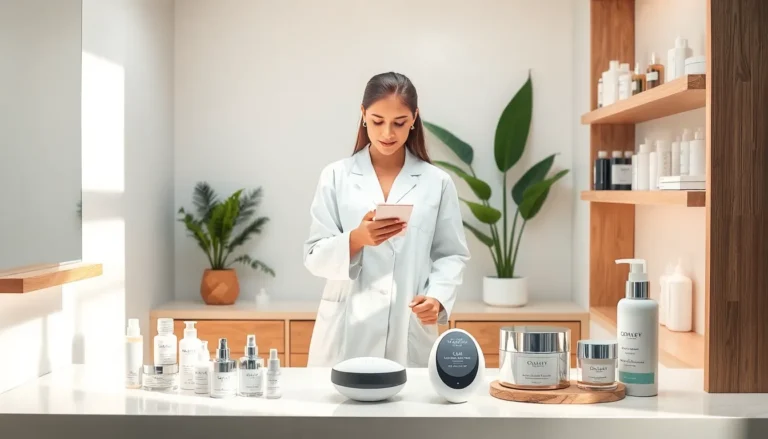In a world overflowing with gadgets and software, finding something that doesn’t require a PhD to operate is like searching for a needle in a haystack. Enter the ease-of-use rating—the superhero of the tech landscape. It swoops in to rescue users from the clutches of confusing interfaces and endless manuals. With a simple score, it tells you whether a product is a breeze to use or a headache waiting to happen.
Table of Contents
ToggleUnderstanding Ease-Of-Use Rating
Ease-of-use ratings assess how user-friendly products such as gadgets and software are. These ratings guide consumers towards options that simplify their experiences.
Definition of Ease-Of-Use Rating
An ease-of-use rating quantifies the simplicity of interacting with a product. It evaluates factors like intuitiveness, accessibility, and the learning curve associated with different technologies. Ratings often employ scales, such as one to five stars, to clearly indicate how easily users can operate a product. Metrics may also include user feedback, testing results, and overall satisfaction scores.
Importance of Ease-Of-Use Rating
Ease-of-use ratings hold significant value for consumers and manufacturers alike. These ratings help users quickly identify products matching their skills and needs. A higher rating often correlates with greater customer satisfaction and loyalty. In competitive markets, manufacturers use these ratings to enhance their products, ensuring they meet user demands for simplicity. Ratings also reduce frustration, making it easier for individuals to integrate technology into their everyday lives.
Factors Influencing Ease-Of-Use Rating
Several key factors affect ease-of-use ratings. Understanding these elements aids both consumers and manufacturers in evaluating user-friendly products.
User Interface Design
User interface design significantly influences ease-of-use ratings. Clarity in layout enhances navigation, allowing users to find what they need quickly. Intuitive icons and clearly labeled buttons improve overall interaction. Consistency in design elements fosters familiarity, reducing the learning curve. Color schemes and font choices also play a role; they should align with users’ expectations and preferences. Additionally, feedback mechanisms, such as notifications or visual cues, guide users through actions seamlessly.
User Experience Considerations
User experience considerations encompass emotional responses and overall satisfaction. Usability testing reveals real-world interactions, providing insights into user behavior. Positive experiences often stem from seamless task completion and minimal obstacles. Involvement of real users in the design process yields better products. Accessibility features expand usability for individuals with varying abilities, ultimately boosting ratings. Lastly, reliable customer support can enhance perception, reassuring users who need assistance. These factors collectively shape the ease-of-use rating landscape.
Methods of Assessing Ease-Of-Use Rating
Various methods exist for assessing ease-of-use ratings, each providing unique insights into user experience. These methods often rely on structured feedback from users and direct observations of interactions with products.
Surveys and Questionnaires
Surveys and questionnaires gather quantitative data on user experiences with products. These tools typically include closed-ended questions designed to measure intuitiveness and overall satisfaction. Users respond using scales, frequently one to five stars, facilitating comparisons across products. Open-ended questions may capture nuanced feedback, highlighting specific pain points in usability. This direct user input is valuable for manufacturers aiming to understand user perspectives and enhance product designs.
Usability Testing
Usability testing involves observing real users as they interact with a product. This method focuses on identifying challenges users encounter during tasks. Testers assess factors such as task completion time and error rates, collecting qualitative feedback that identifies usability issues. The involvement of genuine users allows for authentic insights into product strengths and weaknesses. Usability testing ultimately leads to informed design decisions, promoting improvements aligned with user needs and optimizing overall ease-of-use ratings.
Benefits of High Ease-Of-Use Rating
High ease-of-use ratings offer considerable advantages for both consumers and manufacturers. These ratings contribute significantly to overall user experiences and market success.
Increased User Satisfaction
User satisfaction improves when ease-of-use ratings are high. Products with superior usability tend to create a positive emotional response from consumers. Reduced frustration leads to happier users who feel more in control. Intuitive interfaces simplify tasks and streamline processes, making technology accessible to a broader audience. Higher satisfaction scores correlate with repeat purchases and positive word-of-mouth, driving brand loyalty. The combination of these elements also fosters a community of engaged users who share their experiences and recommendations with others.
Enhanced Product Adoption
Product adoption accelerates in environments where ease-of-use ratings shine. Users gravitate toward products that promise an effortless experience. High ratings can significantly influence the decision-making process, as consumers often prioritize ease of use over other features. Technologies that require minimal learning time appeal to both novices and seasoned users alike. As a result, superior adoption rates contribute to improved sales and market presence. Companies that prioritize ease-of-use effectively position themselves as industry leaders, gaining a competitive edge.
Ease-of-use ratings play a crucial role in today’s technology landscape. They empower consumers to make informed decisions by highlighting user-friendly products while pushing manufacturers to enhance their designs. By focusing on factors like user interface design and accessibility, these ratings help create a more enjoyable and efficient experience for everyone.
As technology continues to evolve, the significance of ease-of-use ratings will only grow. Both consumers and manufacturers benefit from prioritizing usability, leading to increased satisfaction and brand loyalty. Embracing ease-of-use not only simplifies technology integration into daily life but also fosters a more competitive market where innovation thrives.






